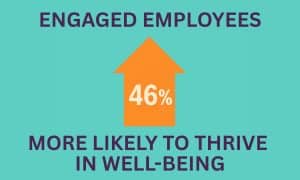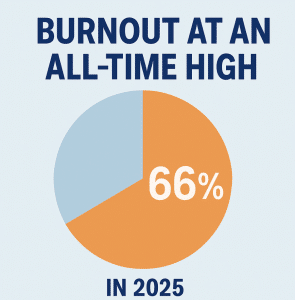The conversation around workplace wellness is often centered around perks like meditation apps, gym reimbursements, or mental health days. While these tools matter, the structure of the work itself — what people do every day and how they do it — is also crucial because it has a far greater impact on well-being than most employers realize. From task overload to lack of autonomy, poorly designed roles can quietly erode employee health and morale over time.
Instead of retrofitting wellness into existing jobs, the smarter approach is to design jobs from the ground up with well-being in mind. When roles are crafted thoughtfully they can reduce stress, enhance engagement, and support both performance and personal health. That’s why employers must design jobs that don’t just get the work done, but do so in a way that sustains the people doing it.
Why Job Design Matters for Well-Being
When you overlook the foundational structure of work such as tasks, autonomy, and interaction, you risk creating unhealthy working conditions. Job design determines how the day-to-day actually functions: the tasks people perform, how much control they have, how they connect with others, and the flexibility they experience.
Effective job design nurtures physical, mental, and emotional health. It prevents overwork, boosts motivation, and empowers employees to grow. And when workers feel that their roles support their overall wellness, engagement, creativity, and loyalty naturally follow. Plus, when people are engaged — something thoughtful job design supports — they’re 46% more likely to thrive in all dimensions of well‑being and benefit from a better quality of life.

Balancing Clarity and Autonomy
A key ingredient of well-designed roles is the blend of clear expectations with meaningful freedom. Employees need structure like knowing what success looks like and where they need to focus their efforts. But they also need autonomy and the ability to choose how to fulfill their responsibilities.
This balance not only fosters trust and passion, but also reduces micromanagement and encourages team members to own their work. The result is stronger performance, better mental health, and reduced stress.
Avoiding Overwork and Burnout
Burnout is more than exhaustion. In fact, recent research shows that burnout is at an all-time high of 66% in 2025. It’s a deep, systemic collapse of motivation and purpose. And job design plays a major role in preventing it.
Set Reasonable Workload Expectations
Design roles with realistic goals and timeframes. If work consistently spills beyond working hours, it’s a sign that load exceeds capacity.
Build in Breaks and Boundaries
Encourage workers to turn off halfway through the day and take lunch away from their desks. They should also use their vacation time.
Allow for Flexible Scheduling
Even small adjustments like starting earlier or cutting out early once a week can ease the pressure of a rigid schedule.
Monitor Well-Being Signals
Encourage managers to notice signs. Staff working late, missed deadlines, or decreased collaboration are all cues to reassess workloads.
Well-designed roles, equipped with pause mechanisms, help employees maintain energy and focus rather than consistently depleting them.

Building Recovery Into the Workday
Although rest is an essential part of performance and creativity, work culture rarely reflects this fact. Designing roles that include recovery creates space to work and breathe.
Frequent Micro-Breaks
A short walk around the block, a few minutes of mindful breathing, or stepping away from a screen can be revitalizing and is easy to formalize.
Scheduled Collaboration-Free Time
Block time in calendars for heads-down work where meetings aren’t allowed. Doing so helps reduce distraction and mental fatigue.
Meeting-Free Days or Golden Hours
Designate one day or a couple of hours a week where no meetings are allowed. Allow time for deep work, reflection, and mental reset.
Fostering Social Connection and Psychological Safety
Well-being isn’t just about the individual. It’s about the social unit as well. Good job design embeds opportunities to connect and support one another.
Make Time for Meaningful Check-Ins
Regular one-on-ones shouldn’t just be about performance. Use check-ins to strengthen social bonds and let leaders tune in to stress or burnout.
Mix Up Team Interactions
Balance task-driven meetings with casual catch-ups, peer coaching, or learning lunches.
Normalize Vulnerability
Share stories of success and struggle. When leaders own up to mistakes, it builds trust and improves collective resilience.
Creating Feedback Loops for Sustainable Work Design
Great jobs evolve. What worked yesterday won’t always hold up today. Feedback loops mean knowing when to pivot, refresh, and course-correct job design.
1. Ask Employees Regularly
Pulse surveys, off-cycle focus groups, suggestion boxes — quick channels that track stress levels, clarity of role expectations, workload balance, and energy levels over time.
2. Use Data to Map Health Dynamics
Look for patterns. If absenteeism spikes after busy months, or turnover climbs among certain roles, it might be time to reassess responsibilities and expectations.
3. Pilot Changes Before Rolling Out
Trial shorter hours, flexible schedules, or extended breaks in small teams, gather feedback, then scale what works.
4. Celebrate Improvements and Course-Correct
Whenever change improves well-being or performance, acknowledge it. When it doesn’t, adjust transparently and intentionally.
Tailoring Roles for Diverse Needs
One size doesn’t fit all, especially if your workforce spans ages, life stages, cultures, or abilities. Inclusive job design honors that diversity. To tailor roles for diverse needs, consider offering compressible work hours, hybrid models, or reduced schedules. You may also want to customize roles to accommodate mobility limits, caregiving responsibilities, neurodiversity, or mental health needs. Remember to also support alternative paths to success, not just the 9–5 hero narrative.
Rethinking Task Variety and Impact
Monotony pollutes motivation; meaning breathes life into it. A well-designed role:
- Includes varied tasks, avoiding repetitive workload.
- Ensures clear meaning and impact, making it obvious how each task contributes to something bigger.
- Allows space for creative contribution or problem-solving input — and access to feedback that connects individual effort and organizational outcomes.
By weaving purposeful variety into roles, employees gain more control, energy, and satisfaction in their work.
Leading the Change: Role Redesign Tips for Managers
To redesign roles, rethink how work gets done to support both performance and well-being.
Step 1: Start With Empathy
Talk with team members about how their days feel. Ask them what energizes them and what drains them. When their lived experience becomes the blueprint for redesign, it’s more effective and meaningful.
Step 2: Audit Tasks Honestly
Map what roles actually do versus what they should do. Find areas to redistribute, simplify, or automate.
Step 3: Co-Create Changes
Employees are most invested when they’re part of designing their own roles. Invite them into the ideation process.
Step 4: Pilot Intentionally
Try small shifts first such as an hour-late start, or early wrap-up. Then, gather real feedback.
Step 5: Respect Time Boundaries
Don’t ask people to review changes outside of working hours. Design within available capacity.
Step 6: Document Improvements
Share working examples across teams. Seeing positive results spreads motivation.
Designing Jobs That Promote Health
When organizations intentionally build roles that support balance, autonomy, recovery, connection, meaning, and sustainability, they honor both human potential and business performance. But creating roles that truly support well-being requires the right tools, insights, and infrastructure.
That’s where CoreHealth comes in. As a leading wellness platform, CoreHealth empowers organizations to go beyond surface-level perks and address well-being at its roots — through smarter program design, data-driven insights, and scalable engagement tools. Whether you’re rethinking job structure, launching new well-being initiatives, or measuring impact, CoreHealth provides the flexibility and support you need to build a healthier, more resilient workforce.
Ready to take a more strategic approach to employee well-being? Book a demo with CoreHealth today to see how our platform can support your goals.
Learn more about wellness programs with these articles from the Corehealth blog:
4 Population Health Management Goals to Strive For
Are Corporate Wellness Programs Worth It? Cost vs. Benefit Analysis
5 Ways Wellness Companies Are Evolving Their Wellness Programs